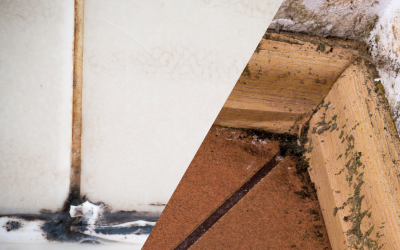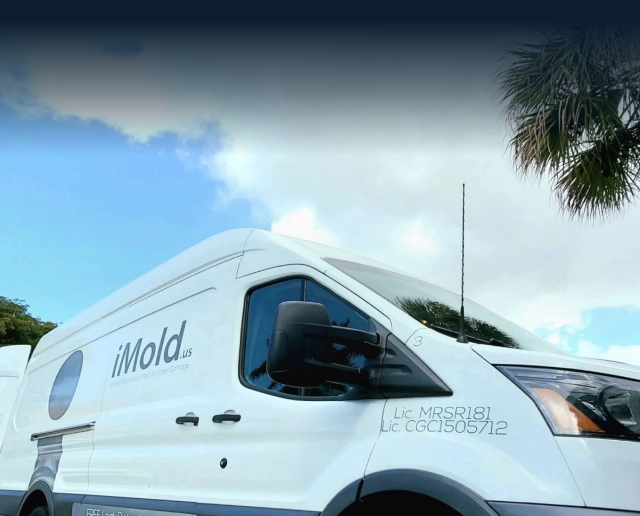Decoding the Visual Difference Between Mold and Mildew and Why it Matters
Homeowners often find spots on walls, ceilings, or damp areas. They wonder if it’s mold or mildew. The difference between mold and mildew might seem subtle, but it’s essential to understand how to remove them and prevent health hazards. This blog will explain the visual difference between mold and mildew.
Difference Between Mold and Mildew: A Quick Overview
Mold is a fungus that tends to have a fuzzy or slimy appearance. It thrives in damp and dark environments, making basements, bathrooms, and attics common breeding grounds. On the other hand, mildew is a surface fungus that typically grows in flat, powdery patches. Understanding the difference between mold and mildew is crucial. While both can cause respiratory issues and damage your home, recognizing them is essential for effective remediation.
Decoding Mold: A Closer Look at Its Visual Traits
Understanding the visual cues of mold is vital for early detection and proper remediation. Let’s break down the key characteristics that set mold apart.
- Fuzzy Texture: The Mold Signature – One of the primary visual cues for mold is its fuzzy texture. When you notice a surface covered in what appears to be a soft, furry layer, it’s likely mold. Mold spores spread through the air and latch onto surfaces, creating this distinctive appearance. If you run your fingers across the affected area and it feels fuzzy, it’s a clear sign that mold is present.
- Diverse Colors: Mold’s Palette – Mold comes in various colors, from black and green to white and orange. This versatility in color makes it challenging to pinpoint mold based solely on its hue. However, combining a fuzzy texture with vibrant or dark colors strongly indicates mold growth. Keeping an eye out for these visual cues can help you differentiate mold from other common household issues.
Identifying Mildew through Visual Clues
Now, let’s shift our focus to mildew and the distinct visual characteristics that set it apart.
- Powdery Texture: Mildew’s Telltale Sign – Mildew exhibits a powdery or fluffy texture, unlike mold. When you come across a surface with what seems to be a thin, delicate layer, you’re likely dealing with mildew. This characteristic distinguishes mildew from mold, offering a visual cue for promptly identifying and addressing the issue.
- Limited Color Range: Mildew’s Subdued Palette – Mildew tends to stick to a more limited color palette, usually in shades of gray, white, or yellow. This restrained range of colors makes mildew easier to identify than the diverse hues associated with mold. While mold can be vibrant and attention-grabbing, mildew often lurks in subtler tones, emphasizing the importance of keen observation.
The Impact on Your Home and Health
Beyond the visible damage and health implications, the difference between mold and mildew can profoundly impact indoor air quality. Understanding this connection emphasizes the need for proactive measures to maintain a healthy living environment.
- Mold’s Respiratory Threat – Mold spores can trigger various health issues, particularly for individuals with respiratory conditions such as asthma or allergies. Breathing in mold spores can lead to coughing, sneezing, and even more severe respiratory complications.
- Structural Damage – Mold has a destructive impact on the structural integrity of your home. It can eat away at building materials like wood and drywall, compromising the strength of your home’s infrastructure.
- Mildew’s Cosmetic Challenge – While mildew may not pose the same structural threats as mold, it can tarnish the aesthetics of your home. Powdery patches on walls or ceilings can be unsightly and challenging to remove. By distinguishing mildew from mold, you can employ targeted cleaning methods and maintain the visual appeal of your living space.
- Compromised Indoor Air Quality – Mold and mildew can significantly compromise indoor air quality, leading to respiratory issues for occupants. Mold spores become airborne, circulating through the HVAC system and infiltrating living spaces. Individuals with respiratory conditions may experience aggravated symptoms, while healthy individuals can be susceptible to throat irritation and coughing. Prioritizing clean air through regular maintenance and mold prevention measures is essential for the overall well-being of your household.
- Green Cleaning Solutions – When tackling mold and mildew, consider environmentally friendly and health-conscious cleaning solutions. Traditional cleaners may contain harsh chemicals that can contribute to indoor air pollution and cause respiratory irritation. Opt for natural alternatives like vinegar, baking soda, or hydrogen peroxide, which effectively combat mold and mildew and promote a healthier indoor environment. This eco-friendly approach aligns with a broader commitment to sustainable living.
Addressing Mold and Mildew Effectively
Now that we’ve covered the visual difference between mold and mildew and understand their potential impacts, you can proactively address these issues in your home.
- Regular Inspections: Early Detection is Key – Implementing a routine inspection schedule for your home is crucial for the early detection of mold and mildew. Regularly check areas susceptible to fungal growth, such as corners of bathrooms, under sinks, and around windows. Please pay attention to any musty odors, which can indicate hidden mold. By catching these issues in their early stages, you can address them before they escalate into more significant problems.
- Consultation with Professionals: Mold Matters – If you suspect mold growth in your home, it’s advisable to consult with mold remediation professionals. They have the expertise and tools to assess the extent of the issue and implement effective removal strategies.
- Moisture Control: A Key Defense Against Fungal Growth – Mold and mildew thrive in damp environments, making moisture control a fundamental aspect of prevention. Regularly inspect your home for leaks, especially in areas prone to water exposure, like basements and bathrooms. Ensure proper ventilation in these spaces to reduce humidity levels, creating an inhospitable environment for mold and mildew to flourish. Investing in dehumidifiers can also be effective, particularly in humid climates.
- DIY Cleaning for Mildew: Tackling Surface Issues – A DIY approach is often sufficient for mildew. You can address mildew on surfaces with water and mild detergent. However, wearing protective gear, such as gloves and a mask, is essential to minimize exposure. Regular cleaning routines can help prevent mildew from reoccurring.
To stay current with us, please follow our Facebook and Instagram pages.

